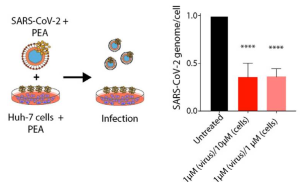A group from Retrovirus Center, Department of Translational Research and New Technologies in Medicine and Surgery, University of Pisa, 56100 Pisa, Italy, etc. has reported that palmitoylethanolamide (PEA) would be a promising adjuvant in the current therapy of COVID-19 or against emerging RNA viruses that share the same route of replication as coronaviruses.
https://pubmed.ncbi.nlm.nih.gov/35632821/
One of the candidate inhibiting molecules against SARS-CoV-2 was PEA, one of the members of the N-acyl-ethanolamine family. PEA has been shown to inhibit peripheral inflammation and mast cell degranulation as well as to exert neuroprotective and antinociceptive effects in rats and mice. Recently, it was discovered that the anti-inflammatory activity of PEA does not follow the same route as anandamide. PEA-induced analgesic and anti-inflammatory activities are mediated by the activation of peroxisome proliferator receptor alpha (PPAR-α). PPAR-α generates a signaling cascade that leads to the disruption of lipid droplets by the activation of β-oxidation within mitochondria and peroxisomes, and the concomitant stimulation of omega-oxidation in microsomes. The efficacy of PEA in the prevention or treatment of bacterial and viral infections has also been reported. This encouraging evidence in the literature has stimulated research as to whether PEA can be used to inhibit the pathogenesis of SARS-CoV-2.
No PEA toxicity was detected, even when PEA was present as high as 100 μM in Huh-7 and 293T cells. When Huh7 cells were infected with SARS-CoV-2 virions incubated or not with PEA at 1 μM, the amount of SARS-CoV-2 genomes were reduced by ~64%, as detected by qRT-PCR 72 h after infection.
The effect of PEA was evaluated against SARS-CoV-2 two variants (Delta and Omicron). It was shown that PEA-pretreated Huh-7 cells at 10 and 1 μM reduced the numbers of viral genomes by 62.4% and 51.2% for SARS-CoV-2 Delta and by 43.4% and 77.3% for the Omicron variant, respectively. Interestingly, it was found that SARS-CoV-2 Delta and Omicron virions exposed to PEA showed a reduction in viral genomes/cell up to nearly 65% for both variants with 10 μM PEA. Also, when PEA was applied to both cells and virions simultaneously. PEA administered at 1 μM led to significant reductions in the number of viral genomes in cell lysate that were quantified as 75.3% and 72.5% for the Delta and Omicron VOCs, respectively.

